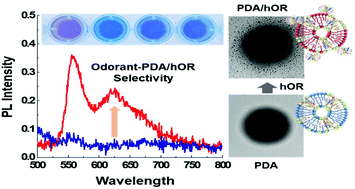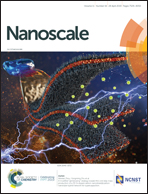Visual detection of odorant geraniol enabled by integration of a human olfactory receptor into polydiacetylene/lipid nano-assembly†
Abstract
A new polydiacetylene lipid/human olfactory receptor nano-assembly was fabricated for the visual detection of an odorant for the first time. The assembly consisted of phospholipid-mixed polydiacetylenes (PDAs) and human olfactory receptors (hORs) in detergent micelles. To overcome the limitations of bioelectronic noses, hOR-embedded chromatic complexes (PDA/hORs) were developed, introducing PDAs that showed color and fluorescence transitions against various stimuli. The chromatic nanocomplexes reacted with target molecules, showing a fluorescence intensity increase in a dose-dependent manner and target selectivity among various odorants. As a result, a color transition of the assembly from blue to purple occurred, allowing the visual detection of the odorant geraniol. Through circular dichroism (CD) spectroscopy and a tryptophan fluorescence quenching method, the structural and functional properties of the hORs embedded in the complexes were confirmed. Based on this first work, future array devices, integrating multiple nano-assemblies, can be substantiated and utilized in environmental assessment and analysis of food quality.



 Please wait while we load your content...
Please wait while we load your content...